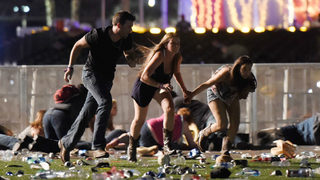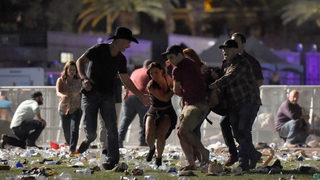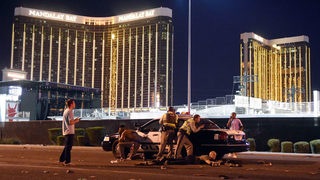LAS VEGAS — Photographer David Becker had finished shooting the final act of the Route 91 Harvest Festival and was in the media tent, filing his photos, when the first round of popping sounds began.
"A security guy said it was just firecrackers, so I went back to work," Becker told Time magazine on Monday.
Little did Becker, who was working the festival for Getty Images, know that he was about to witness firsthand the deadliest mass shooting in modern U.S. history. Suspected gunman Stephen Paddock opened fire Sunday night from his suite on the 32nd floor of the Mandalay Bay Resort and Casino, which overlooked the festival grounds, and killed at least 59 people and wounded more than 500 more.
"The second time I heard the popping sounds, somebody said to me, 'It was just speakers or sound equipment,' and again, I went back into the media tent," Becker told the Washington Post. "Then the noises went again, and that was when the crowd started to flee."

Even as he grabbed his camera and went outside, Becker had no idea what he was seeing. Still, he began shooting photos of the crowd, some of whom were crying, ducking for cover or talking on cellphones.
Becker stood on a table and kept taking photos, telling himself it was a speaker popping, he told both Time and the Post. He had no idea at the time that the sporadic sounds he was hearing was gunfire from automatic rifles being fired about 500 yards away.
>> Read the latest on the Las Vegas shootings
"It was really hard to get a sense of what was happening," Becker said, according to the Post. "At this stage, I still just thought it was a speaker popping, so I was trying to capture people's emotions and a sense of the panic that was around me."
He witnessed a man shielding a woman with his body. Unable to tell if the woman was injured because the lighting was so poor, Becker watched as she and the man got up and ran away.

He saw a man in a wheelchair being helped to an exit. He saw bodies lying on the ground, but could not tell if the people were injured, or just pretending.
"I was trying to capture anything that was moving and that had good lighting," Becker said. "That was critical. It was so dark, and there was limited lighting."
Becker said it was only after he went back into the media tent that he learned the reality of what he was seeing. He called a colleague, who told him that police had called a “code red” and set up a perimeter around the festival grounds.
"It was then I started looking at my photographs, and what I was seeing was just unbelievable," Becker said. "It had been so dark outside, I couldn't see the details. I just saw a lot of people laying on the ground, thinking they were playing possum, but now I could see people covered in blood and I thought, 'This is real.'

“When I saw the image of the woman lying on the ground, covered in blood, that was when the impact of what I was experiencing hit. When I realized people were dying.”
Becker kept editing and filing his photographs, working solely by the light of his laptop after officials cut the power to the venue to help hide those cowering in fear. After several minutes of working, police officers arrived and escorted him to his car.
See more photos from Becker and other photographers in the galleries at the bottom of this story.
The seasoned photographer did not stop working, however. He spent the rest of the night capturing images of law enforcement moving in and those wounded in the shooting helping one another on the streets.

Becker told the Post it is hard for him to comprehend what he saw that night. He said he continued working by using his instinct to "photograph first and ask questions later," which he said is "second nature" for a photojournalist.
“I was on autopilot, just doing my job capturing what was happening, which I think is important,” Becker said. “Impactful images like these tell a story, they move people to think twice about doing anything like this.”
Cox Media Group




